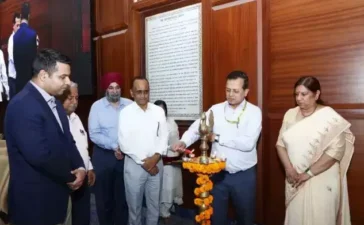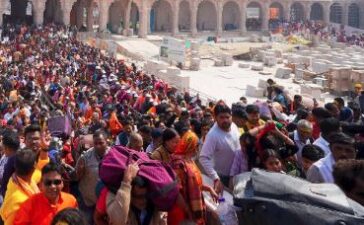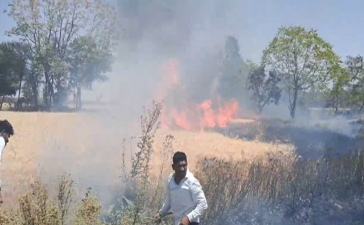गोरखपुर। मुख्यमंत्री योगी आदित्यनाथ ने कहा कि डबल इंजन की सरकार के प्रयासों से छह-सात वर्षों में पूर्वी उत्तर प्रदेश में इंसेफेलाइटिस पूरी तरह नियंत्रित और समाप्त हो चुका है। इसके उन्मूलन की बस घोषणा बाकी है। इंसेफेलाइटिस नियंत्रण देश और दुनिया का एक सफलतम मॉडल है। स्वास्थ्य विभाग को नोडल विभाग बनाकर तैयार किए गए इस सफलतम मॉडल का केंद्र गोरखपुर का बीआरडी मेडिकल कॉलेज है।
सीएम योगी गुरुवार को बीआरडी मेडिकल कॉलेज में एमबीबीएस छात्रों के लिए 60 करोड़ रुपये की लागत से बनने वाले नए प्रशासनिक भवन का शिलान्यास तथा मेडिकल कॉलेज में सोलर रूफटॉप प्लांट के लोकार्पण के उपलक्ष्य में आयोजित समारोह को संबोधित कर रहे थे। मुख्यमंत्री ने कहा कि जिस इंसेफेलाइटिस से हर साल बारह सौ से पंद्रह सौ मौतें होती थीं, आज उसे पूरी तरह कंट्रोल करते हुए हम लोग मासूम बच्चों को बचाने में सफल हुए हैं। स्वाभाविक रूप से उसके लिए जो मैनपावर लगता था, उसमें जो संसाधन लगते थे, उसको हम क्वालिटी ऑफ हेल्थ के लिए अन्य लोगों को भी उपलब्ध कराने में उपयोग कर रहे हैं। उन्होंने कहा कि इंसेफेलाइटिस नियंत्रण के सफलतम मॉडल का केंद्र बिंदु बीआरडी मेडिकल कॉलेज बना क्योंकि सबसे ज्यादा बोझ इसी पर रहता था। उन्होंने कहा कि हमनें इंसेफेलाइटिस का चरम भी देखा है और आज उसे समाप्त होते भी देख रहे हैं।
मॉडल बनाने में मीडिया ट्रायल तक झेलना पड़ा
सीएम योगी ने कहा कि 1977-78 से लेकर 2017 तक इंसेफेलाइटिस को समाप्त करने के बारे में सरकारें सोचती तक नहीं थीं। 2017 में मुख्यमंत्री बनने पर मैंने समाप्त करने, इसके उन्मूलन के बारे में मॉडल तैयार करने पर विचार किया। इसी सिलसिले में कुशीनगर मुसहरों के बीच जाकर स्वच्छता अभियान चलाया। उन्हें स्वच्छता के तरीके समझाए, साबुन के प्रयोग की जानकारी दी। तब मुझ पर तीन दिन मीडिया ट्रायल चला। मीडिया में हंसी उड़ाई गई कि एक मुख्यमंत्री गरीबो को साबुन बांट रहा है। पर, जब कोरोना आया तो ट्रायल करने वाले मीडिया के साथियों को भी साबुन और स्वच्छता की बात समझ में आई।
सफाई खुद में कई रोगों की रोकथाम है
मुख्यमंत्री ने कहा कि स्वच्छता पर ध्यान कई बीमारियों का समाधान है। इसे इंसेफेलाइटिस समाप्त करने की दिशा में मिशन मोड में बढ़ाया गया तो परिणाम सामने आया। 1997 98 से 2017 तक देखा आज परिणाम। बीमारी का चरम भी देखा और आज समाप्त होते भी।
काफी उतार चढ़ाव देखे हैं बीआरडी मेडिकल कॉलेज ने
सीएम योगी ने कहा कि बीआरडी मेडिकल कॉलेज का अपना गौरवशाली इतिहास है। इस मेडिकल कॉलेज ने अनेक उतार-चढ़ाव भी देखे हैं। वह भी दौर देखा है जब इस मेडिकल कॉलेज में यह पूर्वी यूपी का स्वास्थ्य का एकमात्र केंद्र हुआ करता था और वह भी संसाधनों के अभाव से जूझता था। न डॉक्टर थे, न पैरामेडिक्स थे, न नर्सिंग स्टाफ था और न अन्य कार्यों के लिए जरूरी मैनपावर। इस मेडिकल कॉलेज पर 1997-98 में मान्यता का संकट आया था। तब अतिरिक्त प्रयास करने पड़े थे। एमसीआई ने 1998-99 में एक बार फिर से मान्यता को एक प्रकार से वापस ले लिया था। तब मैं तत्कालीन चिकित्सा शिक्षा मंत्री को लेकर दिल्ली गया था, शपथ पत्र दिलवाया था कि हम यहां की आवश्यकता को पूरा करेंगे। तब कहा था कि बीआरडी मेडिकल कॉलेज इस पूर्वी उत्तर प्रदेश के लिए स्वास्थ्य सेवाओं का बैकबोन है। उसको बंद कर देंगे तो सबकुछ बंद हो जाएगा। जो हजारों मौतें इंसेफेलाइटिस से होती हैं, इन मौतों को नियंत्रित कर पाना कठिन हो जाएगा। उस समय शासन की लापरवाही थी, अनदेखी थी। उस समय फैकल्टी अपने स्तर पर प्रयास करते थे लेकिन संसाधन काफी कम थे। एक-एक बेड पर चार मरीज लेटाये जाते थे। पीडिया वार्ड का टॉयलेट चोक था। सुधार के लिए सांसद के रूप में सरकार से अपील की, संसद में आवाज उठाई। 2017 के बाद यहां आए बदलाव की चर्चा करते हुए मुख्यमंत्री ने कहा कि अब यहां बाल रोग संस्थान प्रारंभ हो चुका है। पीडिया वार्ड सुसज्जित और इंफ्रास्ट्रक्चर से संपन्न हो गया है। इसी परिसर में रीजनल मेडिकल रिसर्च सेंटर भी क्रियाशील हो चुका है। सुपर स्पेशियलिटी का ब्लॉक बन चुका है। एक समय सीट आधी हो गई थी, मान्यता पर संकट था। जबकि आज बढ़ी हुई सीट के लिए सरकार स्वयं आपके पास आकर इंफ्रास्ट्रक्चर दे रही है।
बीआरडी की प्रतिस्पर्धा एम्स गोरखपुर से
मुख्यमंत्री ने कहा कि बीआरडी मेडिकल की प्रतिस्पर्धा किसी मेडिकल कॉलेज से नहीं है। यह काफी आगे बढ़ चुका है। अब इसे एम्स गोरखपुर से प्रतिस्पर्धा करनी है। क्वालिटी दोनों की समानांतर चल रही है। थोड़ा प्रयास करेंगे तो एसजीपीजीआई लखनऊ और एम्स दिल्ली की तरह ही बीआरडी मेडिकल कॉलेज तथा एम्स गोरखपुर एक दूसरे के प्रतिस्पर्धी हो जाएंगे। इसके लिए दोनों के बीच नॉलेज का आदान-प्रदान होना चाहिए।
धैर्य और अध्ययन से निकालना होगा समाधान
सीएम योगी ने चिकित्सकों, चिकित्सा शिक्षा के विद्यार्थियों से आग्रह करते हुए कहा कि विपरीत परिस्थितियों में उन पर वर्क लोड हो सकता है लेकिन धैर्य खोए बिना काम करिए। तभी अच्छा चिकित्सक बन सकते हैं। उन्होंने कहा कि हर मरीज की अपनी एक हिस्ट्री, फैमिली बैकग्राउंड, आर्थिक, सामाजिक भौगोलिक परिस्थितियां होती हैं। उनको नोट करते हुए अच्छी स्टडी करेंगे तो मेडिकल क्षेत्र में क्रांतिकारी बदलाव ला पाएंगे। उन्होंने कहा कि बीआरडी मेडिकल कॉलेज में पूर्वी उत्तर प्रदेश के साथ बिहार और नेपाल तराई के मरीज भी बड़ी संख्या में आते हैं। स्टडी से इन सबकी पृष्ठभूमि को समझने में आपको मदद मिलेगी। धैर्य और अध्ययन से समाधान के रास्ते निकलेंगे। उन्होंने चिकित्सकों से नवाचार और शोध के साथ जुड़ने का आह्वान किया।
अब क्लीन एंड ग्रीन एनर्जी का समय
मुख्यमंत्री योगी आदित्यनाथ ने कहा कि अब हम क्लीन एंड ग्रीन एनर्जी की तरफ आगे बढ़कर एक नए मॉडल के साथ आगे बढ़ रहे हैं। क्लीन एंड ग्रीन एनर्जी भविय की आवश्यकता है। 2017 में जब उनकी सरकार बनी थी तब पीएम मोदी ने इसका मंत्र दिया था। उसका अनुसरण कर सरकार ने प्रदेश में बिना रुपया खर्च किए 16 लाख स्ट्रीट लाइट लगवा दी है। इससे बिजली भी बच रही है और कार्बन उत्सर्जन भी कम हो रहा है। ग्रीन हाउस इफेक्ट को नियंत्रित करने में सफलता मिल रही है। उन्होंने कहा कि सरकार ने पॉलिसी बनाई है कि सोलर पैनल लगाने वाले से उसके उपयोग के बाद बची बिजली खरीद कर उसे इसका रुपया दे दिया जाएगा। उन्होंने रूफटॉप सोलर प्लांट लगाने के लिए बीआरडी मेडिकल कॉलेज द्वारा ली गई लीड की सराहना की। सीएम योगी ने कहा कि पीएम मोदी का विजन है कि 2070 तक देश पूरी तरह क्लीन एंड ग्रीन एनर्जी की तरफ जाएगा।
10 लाख करोड़ रुपये के निवेश का होगा एकसाथ शिलान्यास
मुख्यमंत्री ने कहा कि आज एक नया उत्तर प्रदेश सबके सामने है। इसी माह 19 तारीख को देश का सबसे बड़ा निवेश यूपी में होने जा रहा है। ग्राउंड ब्रेकिंग सेरेमनी में पीएम मोदी दस लाख करोड़ की निवेश परियोजनाओं का शिलान्यास करेंगे। ऐसा करने वाला यूपी देश का पहला राज्य होगा। मेडिकल कॉलेज में हुए कार्यक्रम में सांसद रविकिशन शुक्ल, सांसद कमलेश पासवान, जिला पंचायत अध्यक्ष साधना सिंह, महापौर डॉ. मंगलेश श्रीवास्तव, विधायक विपिन सिंह, महेंद्रपाल सिंह, डॉ. विमलेश पासवान, प्रदीप शुक्ल, धर्मेंद्र सिंह, प्रमुख सचिव चिकित्सा शिक्षा पार्थसारथी सेन शर्मा, मेडिकल कॉलेज में सोलर रूफटॉप प्लांट लगाने वाली फर्म ओएमसी पॉवर के एमडी रोहित चंद्रा आदि प्रमुख रूप से मौजूद रहे।
ग्राउंड प्लस फाइव फ्लोर का होगा प्रशासनिक भवन
बीआरडी मेडिकल कॉलेज में 60 करोड़ रुपये से बनने वाला प्रशासनिक भवन ग्राउंड प्लस फाइव फ्लोर का होगा। इसका निर्माण यूजी (एमबीबीएस) की 50 सीटों की वृद्धि के दृष्टिगत कराया जा रहा है।
सोलर रूफटॉप प्लांट से विद्युत व्यय में 72 लाख रुपये की सालाना बचत
बीआरडी मेडिकल कॉलेज में एक मेगावाट क्षमता के जिस सोलर रूफटॉप प्लांट का लोकार्पण आज मुख्यमंत्री ने किया है, उस पर करीब पांच करोड़ रुपये की लागत आई है। इससे मेडिकल कालेज के विद्युत व्यय में प्रति वर्ष 72 लाख रुपये की बचत होगी।







